10
Men from the Northern towns as well as from other parts of Canada welcomed the opportunity to play on mining teams, especially as jobs grew scarce in the 1930s. What's more, players on mining teams were treated quite well: they often received time off (with pay) to practice and play in tournaments, and were independent enough to switch teams if they felt their skills could be put to better use on another team.Transportation between towns could be difficult and tedious at times, so town league competition made it possible for local players to sharpen their skills.
The development of hockey players in Kirkland Lake began with the basics - namely facilities and competition. It wasn't until January 12th 1927 that Kirkland Lake had its first indoor arena, and artificial ice did not make its debut at the Kirkland Arena until 1937. Ice time in the arena would be difficult to come by for those not at the Juvenile or Senior levels of hockey. The majority of the players used outdoor rinks for practice and games. An outdoor ice surface would mean a shorter playing season if it was a mild winter. Because of the distance that separated towns and limited transportation in the form of trains and rough roads, teams in towns like Kirkland Lake found their competition against one another, and encouraging the rivalries between the teams in town, whether they were from a mine league or not.
Industrial and commercial leagues were used as a way of keeping players in the North and playing for local leagues. With rules relating to a players residence and their ability to be transferred in place, players (including the "imported" players) were encouraged to stay in one place. Players were expected to not just play hockey for their employer - if you were hired by a mine, you were also expected to work for the mine, either above or below ground. By working for the mine, a hockey player was able to maintain their amateur player status, and to remain in the leagues.
11
Harold's Hockey TeamCirca 1937
Kirkland Lake, Ontario, Canada
 Credits:
Credits:Donated by Diane Doyan
Hockey Heritage North Archives
12
Butorac's Grocery Hockey TeamCirca 1939
Kirkland Lake, Ontario, Canada
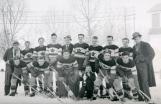 Credits:
Credits:Hockey Heritage North Archives
13
Golden Gate Service Hockey Team PlayersCirca 1940
Kirkland Lake, Ontario, Canada
 Credits:
Credits:Hockey Heritage North Archives
14
Toburn Mine Hockey PlayersCirca 1930's
Toburn Gold Mine, Kirkland Lake, Ontario, Canada
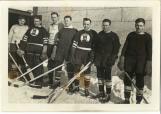 Credits:
Credits:Museum of Northern History
15
But working in a mine came with hazards. The following six images of newspaper clippings are an example of one of the dangers miners faced below ground. Roddy O'Connor worked in the Lake Shore Mine and was a member of the Kirkland Millionaires hockey club prior to the accident.16
Newspaper Clipping - Hockey Player Injured in Mine AccidentCirca March 1936
Kirkland Lake, Ontario, Canada
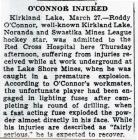 Credits:
Credits:Hockey Heritage North Archives
17
Newspaper Clipping of Hockey Player Mine AccidentCirca March 1936
Kirkland Lake, Ontario, Canada
 Credits:
Credits:Hockey Heritage North Archives
18
Newspaper Clipping of Hockey Player Injured in Mine AccidentCirca March 1936
Kirkland Lake, Ontario, Canada
 Credits:
Credits:Hockey Heritage North Archives
19
Newspaper Clipping of Hockey Player Mine AccidentCirca March 1936
Kirkland Lake, Ontario, Canada
 Credits:
Credits:Hockey Heritage North Archives
20
Newspaper Clipping of Hockey Player Mine AccidentCirca March 1936
Kirkland Lake, Ontario, Canada
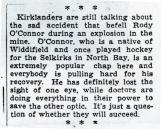 Credits:
Credits:Hockey Heritage North Archives
21
Newspaper Clipping of Hockey Player Mine Accident and RecoveryCirca March 1936
Kirkland Lake, Ontario, Canada
 Credits:
Credits:Hockey Heritage North Archives
22
Mines would often import "tourist" players from outside the area so that they could play on the local teams. There was a problem with having imported players, though. While they were able to produce exciting games for the fans and provide championship titles for the mine owners and managers, the use of imported players meant that the time and money was being invested in players who would in time leave Kirkland Lake - and not in the homegrown talent of the time.Kirkland Lake was not as susceptible to the economic hardships experienced during the Depression as other communities across Canada. Because it was a resource based town, the town did not feel the effects of the Depression as quickly, or as long, as other parts of the country. Where else but in a gold mining town could a hockey team afford to call itself "The Millionaires" during the 1930's.
23
Kirkland Lake Millionaires Hockey ClubCirca 1935
Kirkland Lake, Ontario, Canada
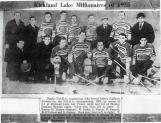 Credits:
Credits:Hockey Heritage North Archives